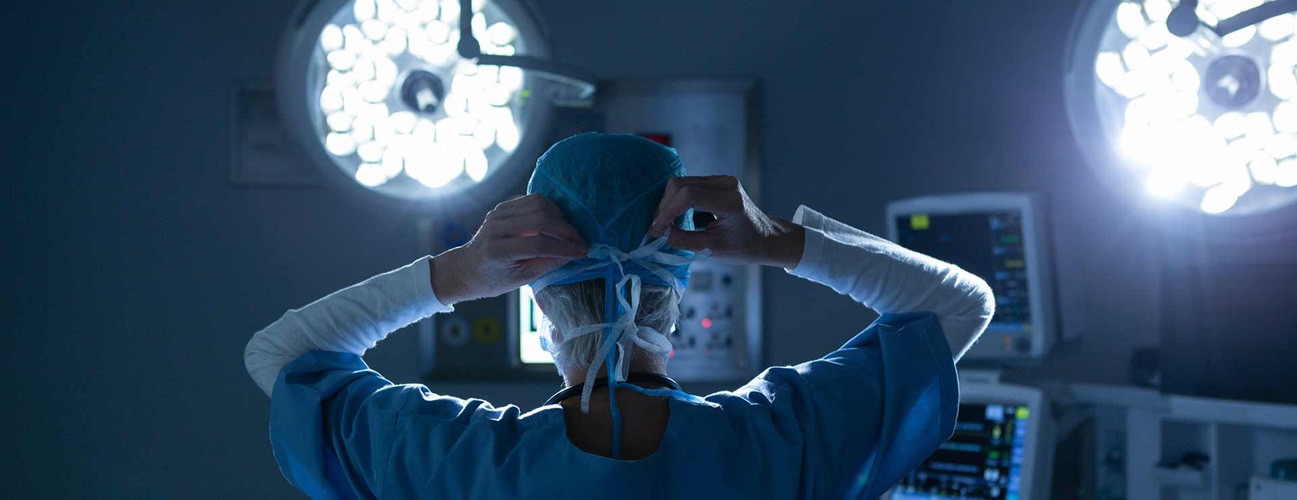Submandibular Gland Excision
Reviewed By:
Three pairs of glands secrete saliva to keep your mouth moist. Salivary stones and other problems with one of the submandibular salivary glands sometimes require surgical removal (excision) of the gland. Head and neck surgeon David Eisele, M.D., explains why the procedure may be recommended and what you can expect.
What You Need to Know
- The surgery is usually performed with general anesthesia. You most likely will go home the day of surgery.
- The incision may be 2 centimeters to 3 centimeters long, and is under your jaw, where it is not likely to be obvious.
- When one salivary gland is removed, the others can provide adequate saliva to help you talk, eat, and swallow. Dry mouth after submandibular gland excision is very rare.
What is submandibular gland excision?
The removal (excision) of a submandibular gland is a common surgical procedure to remove one or both of the salivary glands under the jaw (mandible).
Submandibular Salivary Gland Removal: Why It’s Performed
“The most common reason for submandibular salivary gland removal is a blockage in its duct, where saliva flows from the gland into the mouth,” Eisele says.
Blocked Salivary Gland Ducts and Sialadenitis
For instance, a salivary stone can block the salivary duct and cause sialadenitis, with pain, inflammation or infection in the gland. There are several ways to remove salivary stones, such as sialendoscopy, but in some people, the stones are within the gland, and removal of the gland is needed.
Before recommending surgery, your head and neck surgeon may order imaging studies such as a CT scan to see the submandibular gland and learn more about what is interrupting saliva flow.
Eisele adds that removing a salivary gland is part of managing salivary gland cancer. “Additional treatments may include radiation therapy and additional surgery, including lymph node removal and reconstructive procedures,” he notes.
Submandibular Gland Removal for Sialorrhea
Another reason your doctor may consider removing a salivary gland is to control a condition called sialorrhea (excessive salivation or drooling).
Sialorrhea can affect people with neurologic problems such as Parkinson’s disease or stroke that impair the control of muscles in the mouth and face. Treatment, such as use of botulinum toxin, may control sialorrhea. If medication is not effective, the doctor may discuss surgical salivary gland removal to manage excessive salivation.
“We tend to see sialorrhea most often in children affected by degenerative muscular disease, including muscular dystrophy,” Eisele says. “If the disease affects the child’s ability to swallow and clear saliva from the mouth, aspiration ― inhaling the excess saliva ― is a real danger, and can lead to choking or pneumonia.
“In the case of people with Parkinson’s disease, removing a gland may not be necessary. For some patients, we may be able to surgically tie off one of the salivary ducts to manage excess saliva,” he adds.
Preparing for Salivary Gland Removal
History and examination. The surgeon will meet with you and perform a complete medical history. He or she will examine your face, neck, jaw and the inside of your mouth, and feel for stones, masses or other lesions. The exam will include a look at the symmetry of your face and the function of nerves that move the corners of your mouth.
Imaging. Imaging tests may include head and neck CT and ultrasound. If the doctor suspects a tumor, you may have a fine needle aspiration biopsy to help the doctor diagnose the tumor type. A cancerous salivary gland tumor calls for a different treatment plan.
Once you and your surgeon agree that submandibular gland excision is the right choice for you, your surgery is scheduled. The procedure is considered outpatient.
Submandibular Gland Excision Procedure: What to Expect
The surgery itself takes about an hour and a half, but the entire process, including pre-op preparations and recovery after the procedure, takes about six hours. You will be given local or general anesthesia to make sure you are comfortable throughout the surgery.
The surgeon makes an incision (cut) in the skin crease below your jaw, where a scar will be less visible. The incision may be 2 centimeters to 3 centimeters long.
Next, the surgeon and team locate the salivary gland and carefully free it from its surrounding tissues and structures. Then, the gland is removed in its entirety, and the wound is closed.
Once you have awakened from anesthesia and your surgeon examines you, you may spend the night at the hospital before you are released. You will be given pain relief to take as you recover at home.
Salivary Gland Surgery: Risks and Complications
Safeguarding Nerves
Several important nerves are located near the salivary glands, and your surgeon and team take care to avoid disrupting or damaging them during this operation.
“Facial nerve monitoring techniques during the procedure protect the marginal mandibular nerve, which allows the function of muscles in the chin and lower lip,” Eisele explains.
Other nerves that will be protected during submandibular surgery include:
- The lingual nerve, which controls tongue sensation.
- The hypoglossal nerve, which allows the tongue to move.
Salivary gland surgery that disturbs these nerves can result in temporary changes in movement, weakness or diminished sensation in the areas they control. Permanent damage to these nerves is a rare complication.
Additional Complications
Submandibular gland removal complications are possible, and in addition to nerve bruising or damage described above, can include:
- Bleeding
- Infection
- Scarring
- Seroma: a buildup of fluid under the skin that can form a cyst or lump.
Salivary Gland Removal Recovery
After the procedure, you will most likely have a drain in place to prevent a buildup of blood and fluid in the wound. The doctor will remove the drain a few days after your surgery, and you may notice some minor bruising.
You will be asked to follow your doctor’s instructions for wound care, which will include keeping your surgical wound clean and dry, and not straining or lifting any heavy objects.







